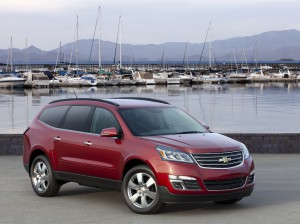
The popularity of large utility vehicles and pickups has caused the average fuel economy of new vehicles to dip this year.
The surge in demand for pickups, utility vehicles and other light trucks has taken a toll on fuel economy. For the first time since it started tracking the numbers, the mileage of the typical vehicle sold in the U.S. dipped slightly this year, according to the University of Michigan Transportation Research Institute. But the mpg ratings for many vehicles are expected to take an even bigger hit for 2017.
With the Environmental Protection Agency revising its testing procedures for the new model-year, about 30% of all new models will see at least a modest dip in their reported fuel economy, according to a study by website Cars.com. In some cases, the impact will be significant. The 2017 Volkswagen Passat, for example, will suffer a 4 mpg dip in its highway rating, and a 2 mpg decline in its combined number.
The change in the way the EPA calculates fuel economy could make it difficult for shoppers who were hoping to consider this year’s figures to those from 2016. And it could paper over what, in some cases, might be an actual improvement in fuel efficiency by some models.
It’s just the latest in a series of adjustments the EPA has made during the past four decades, since the introduction of the Corporate Average Fuel Economy, or CAFE, standards. The move is meant to make the numbers shoppers see on that Munroney, or window, sticker found on all new vehicles a bit closer to what motorists can expect to get in real-world conditions.
(How will looming CAFE rules affect the economy? Click Here to find out.)
In 2008, the agency made some significant adjustments to the CAFE ratings to bring things more in line. It put a particular emphasis on hybrids, such as the Toyota Prius, that time, reflecting the wide gap between rated and real-world fuel efficiency at the time.

The appeal of full-size trucks combined with low gas prices are the catalysts for growing pickup sales and falling fuel economy numbers.
The Cars.com study looked at the mileage ratings of 75 high-volume products that were undergoing no mechanical or aerodynamic changes for the 2017 model-year. Of the 84 individual variants of those models, the analysis found that 23, or 27.4%, saw their fuel economy ratings drop for the 2017 model-year.
Some of the most popular models negatively affected by the updated testing process are the Honda Accord, Hyundai Sonata and Toyota RAV4.
According to the EPA, a small number of vehicles, about 1% of those it tracks, may actually see an increase in their rated fuel economy. And the vast majority will stay the same.
(Click Here to see how keeping the CAFE standards will save drivers big cash.)
The new system could prove challenging for both manufacturers and consumers. Among other things, it could make it difficult for comparison shopping since, from a buyer perspective, mileage would appear to be dropping on some models.
The EPA plans to update its own website, however, to make it easier to compare mileage as far back as the 2011 model-year.
The 2017 test changes are not quite as severe as those put in place for 2008. Back then, the EPA switched from a two-cycle – City and Highway – testing procedure to a five-cycle test. It also tried to account for variables motorists see every day, such as weather and road conditions. The numbers that came out of that update were far closer to real-world results, but the agency is hoping to make things even more accurate with the 2017 revisions.
The EPA is currently in the process of ramping up the U.S. fuel economy standards, targeting 54.5 miles per gallon by 2025. But that difficult target is undergoing a mid-cycle review and many automakers are pressing the government to ease back a bit. The feds have so far said they will hold to that target, but a final decision won’t be announced until next year.
(To see why Americans favor tougher fuel economy standards, Click Here.)
As with the mileage sticker on vehicle windows, there’s a bit of a gap between the 54.5 mpg goal and what the industry will actually have to achieve by 2025. Because of credits manufacturers can earn from things like battery-electric vehicles, as well as credits for the various adjustments to mileage testing practices over the years, the actual 2025 figure is expected to be closer to the mid-40 mpg range.
